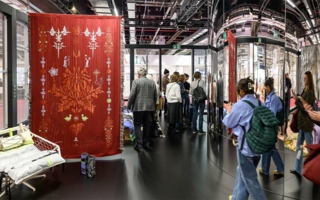27/08/2015 — auf Deutsch lesen
It´s the fashion blog, stupid!
A wordpress account, a phone camera and a good sense of style – nowadays that is all it takes to start a fashion blog. Young, hip people talk about trends, present their own or other’s outfits and discuss topics such as fashion, lifestyle, beauty and much more.
Roland Schweins, founder of the platform styleranking, estimates the number of active bloggers in Germany to about 5,000. Although they have not been taken too seriously in the beginning, some blogs transformed into successful businesses. Today, bloggers sit in the first row at the major fashion shows – next to journalists from Vogue, Elle and co. The direct contact to target groups and the enormous reach of some blogs make them relevant players in the industry.
This July, the association for consumer research („Gesellschaft für Konsumforschung“, GfK) conducted a study on the influence of fashion blogs in Germany. Using a method called network analysis, they analysed data from more than 50.000 twitter users. Among other things, the GfK determined trendsetters and opinion leaders in the German fashion blog scene.
Network analysis looks at the actual connections and information flows between users and communicators. Based on the three factors influence, reach and interest congruence, the eventual network index can be calculated for each blog individually.
Following these calculations, the most influential bloggers in Germany is Anna Frost aka fashionpuppe. Although Nilam Farooq attracts more than ten times as many followers with her videoblog daaruum, she only reaches the second place after Frost. This is because influence is not measured in mere numbers of followers in social media, but in actual opinion leadership.
Apart from single blogs, the GfK also compared the overall influence of blogs compared to traditional media. Especially regarding the topic of haute couture, traditional outlets such as magazines still play a dominant role for the customers. However, the topic of casual dressing turned out to be far more relevant for the users – and here it is blogs that own the conversation.
In sum, blogs also rose to become online opinion leaders in Germany while such trends have been visible in countries such as the US or the UK for quite some years already. Yet, it has to be pointed out that the GfK merely analysed data from highly active twitter users for this study. As they – by definition – have a higher affinity to social media and online communication as the average customer, these results may overestimate the importance of blogs. Nevertheless, they show the great potential of fashion blogs that keeps growing over the last decade.
Yet, what may at first glance look like an easy business – talk about fashion and shoot a video from time to time - turns out to be a rather hard job which seldom leads to financial success. According to Roland Schweins, only every 5th fashion blog in Germany generates money. Around 200 bloggers can make a living with their outlets, yet there are no exact numbers.
Sources of income are primarily advertising collaborations with fashion and beauty companies. Aside from classic banner advertisement, companies are mainly interested in sponsored posts. Advertorials are also highly popular as the authenticity of the blogger can increase brand exposure and brand experience significantly.
Fashion blogs differ from traditional fashion media not only in terms of advertising possibilities. They enable interactive communication between target groups and brands. Thus they challenge the elitist character of the fashion industry, which is traditionally controlled by an exclusive circle of magazines and designers. Some even speak of a democratization of fashion. Now it is the real people that have a say and are enabled to present fashion not as an unreachable object of art but as wearable, daily garments of clothing.
Both costumers and brands shift their focus of communication and information to the web – and this is where the bloggers create buzz, connect people and set trends.
However, not all that blogs is gold. In particular the balance between platform financing through advertisement and the authenticity and transparency of blogs is difficult and will remain one of the main topics to discuss for the future of fashion blogs.
[Hannah Werner]
[blog.gfk.com]
[fashionpuppe.com]




